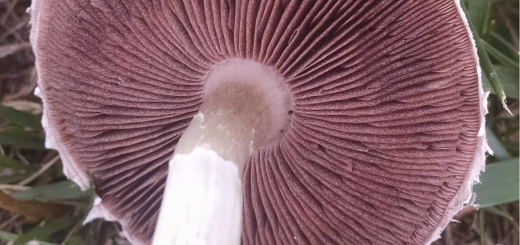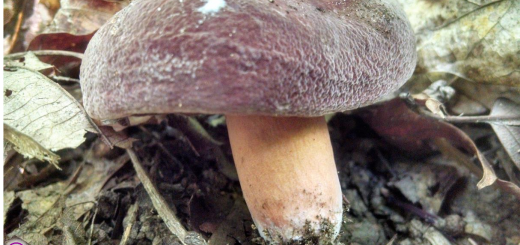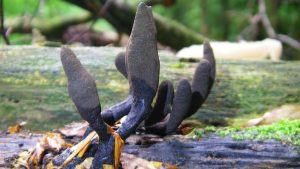#066: Ophiocordyceps sinensis
This fungus parasitizes caterpillars in the Himalayas and produces small, spike-like mushrooms. These mushrooms are highly prized for their supposed medicinal properties and have brought a lot of new wealth and new problems to the people living in the Himalayas. Ophiocordyceps sinensis fruiting bodies are known as “Yartsa Gunbu” in Tibetan and “Dōng Chóng Xià Cǎo” in Chinese, both of which translate to “winter worm, summer grass.” The English names for the fungus are much less colorful: “Caterpillar Fungus” or (more recently) “Himalayan Viagra.” sinensis (Fungi, Ascomycota, Sordariomycetes, Hypocreales, Ophiocordycipitaceae) is native to the meadows of the Himalayas and Tibetan plateau and can be found from 3,000m to 5,000m above sea level. The parasitic fungus infects a variety of species of ghost moth larvae that live underground. It initially infects the caterpillars in the late summer. By winter, the fungus is ready to kill its host. At that time, it maneuvers the caterpillar into position: the head facing up just a few centimeters from the surface. O. sinensis then mummifies its host and forms a small bud of fungal tissue at the top of the larva’s head. In the spring, the bud grows into a small fruiting body and can be found poking out of the ground among blades of grass, still connected to its dead host. The roughly cylindrical mushrooms are small – no more than 10cm long and only a few millimeters thick – and are black to dark brown. It is this phase of the fungus’s life cycle that suggested its local name. Like many other fungi, O. sinensis was originally assumed to be a plant. Anyone who came across this strange organism could easily believe that the worm had some magic that allowed it to transform into a blade of grass during the summer.
Traditional medicine of the Himalayan region holds that Yartsa Gunbu can be used to cure virtually any ailment, from cancer to asthma. The earliest texts place a great emphasis on the mushroom’s use as an aphrodisiac. Today, O. sinensis is still believed to cure almost any malady imaginable, including: erectile dysfunction, back pain, high cholesterol, poor eyesight, cancer, viral infections (like HIV), and even hair loss. Many scientific studies, mostly conducted in China, have focused on the health benefits of various compounds extracted from O. sinensis. These link the fungus to a myriad of positive effects, such as: reducing depression, supporting the immune system in multiple ways, preventing tumors, improving memory, and treating bowel and kidney injuries. However, no large-scale clinical trials of the mushroom have been carried out, so its actual health effects are not known. The fungus can be eaten a number of ways: as a tea, in a soup, or cooked with meat. Both the fruiting body and mycelium-filled caterpillar shell are eaten.
Regardless of the effectiveness of O. sinensis, the world is in the midst of a Yartsa Gunbu craze. Demand for Yartsa Gunbu is so high that prices can reach $2,000 (USD) an ounce, making the fungus more valuable than gold. The profits from Yartsa Gunbu collection can make up 80% of a household’s income. Harvesting is usually a whole-family affair and children, who are particularly adept at finding the tiny mushrooms, are often absent from school in order to help with collection. China’s growing economy is the main force driving the increase in demand for Yartsa Gunbu. In China, it is considered a status symbol and is often presented as a gift to government officials. Not surprisingly, the experience buying top-quality Yartsa Gunbu can be a lot like buying jewelry (read the National Geographic article linked below for more).
This enthusiasm for this fungus has brought an unexpected infusion of wealth to the Himalayan region and has created a number of new problems for the area’s residents. This new wealth has been used for a variety of purposes: to buy personal items like iPhones, motorcycles, and solar panels; to improve a town’s infrastructure and public services; and to build hotels to attract tourists and diversify the economy. With all this new wealth come new problems. There have been a number of murders in the region directly related to Yartsa Gunbu collection. Local communities also have to design ways to regulate Yartsa Gunbu season to ensure fairness. They also must come up with ways to deal with outsiders looking to get in on the Yartsa Gunbu gold rush. On top of all this, the supply of Yartsa Gunbu is decreasing. A survey in Nepal found that trade had decreased by 50% from 2009 to 2011. In the Tibetan plateau, supply has dropped 10% to 30% from three decades ago. A major cause of this is that most mushrooms are picked before they start producing spores, so the fungus does not have an opportunity to infect new hosts. Global warming and the resulting climate change are probably also contributing to the decline in production. Loss of O. sinensis from the environment due to overexploitation could have unforeseeable consequences, since the fungal control of the ghost moth population would be removed. In order to ensure a continuous supply of Yartsa Gunbu, local communities need to come up with enforceable management strategies. A recent NPR article (linked below) described one village that sets limits on how early the harvest can begin and prohibits collection from sacred areas. Hopefully similar practices will be implemented elsewhere and will help preserve O. sinensis for the future.
Note: Read the articles below to get a better look at the culture and economy of Yartsa Gunbu.
See Further:
http://ngm.nationalgeographic.com/2012/08/tibetan-mushroom/finkel-text
http://www.nature.com/news/overharvesting-leaves-himalayan-viagra-fungus-feeling-short-1.12308
http://www.ncbi.nlm.nih.gov/pubmed/24716152









![#011: Characteristics of Kingdom Fungi [Archived]](https://www.fungusfactfriday.com/wp-content/themes/hueman/assets/front/img/thumb-small-empty.png)


1 Response
[…] Gunbu (Ophiocordyceps sinensis, FFF#066) is once again in the headlines over long-term supply fears. The fungus, which infects […]